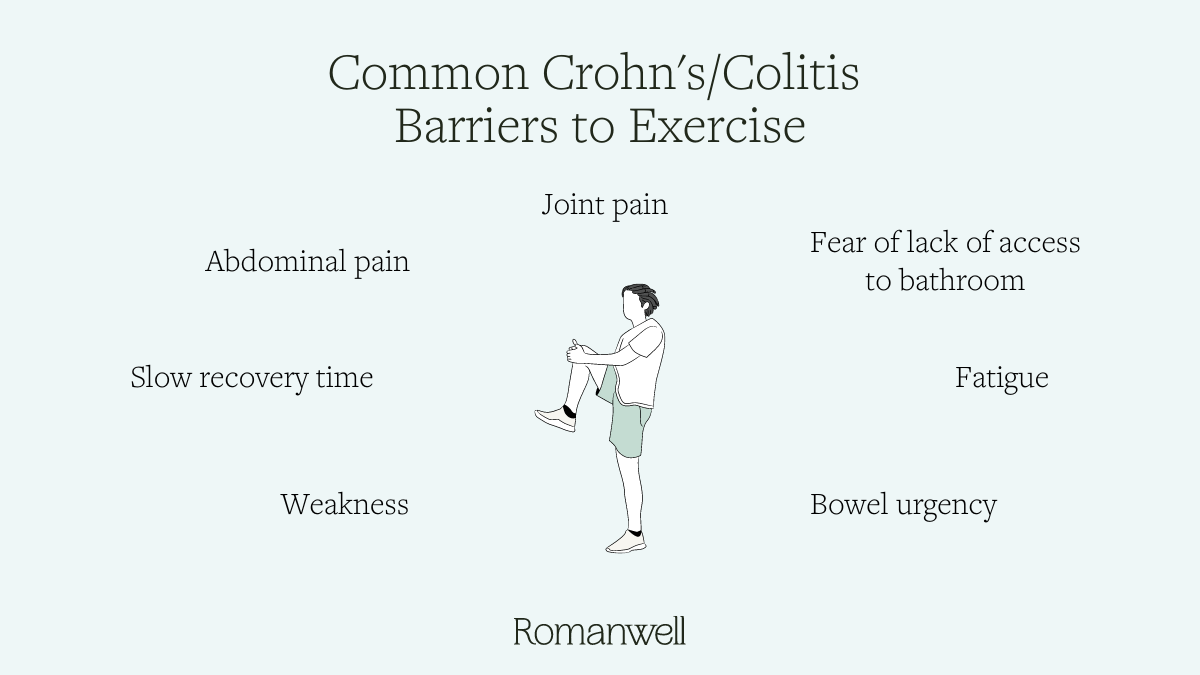
Living with Crohn’s disease presents unique challenges, particularly when it comes to maintaining a regular fitness routine. Exercise offers numerous health benefits, including improved cardiovascular health, reduced stress levels, and better overall well-being. However, for individuals with Crohn’s, intense workouts can sometimes exacerbate symptoms or trigger flare-ups. The key is to find a balanced approach that allows you to stay active without compromising your digestive health.
Why Exercise is Important for People with Crohn’s Disease
Many people with Crohn’s disease may hesitate to exercise due to concerns about symptom flare-ups. However, research suggests that moderate, low-impact physical activity can actually help manage inflammation and improve overall health. Here are some benefits:
- Reduces Inflammation – Regular exercise has been shown to decrease systemic inflammation, which plays a significant role in Crohn’s disease.
- Enhances Mental Well-being – Physical activity releases endorphins, reducing stress and anxiety, which can be triggers for flare-ups.
- Boosts Immune Function – Moderate exercise strengthens the immune system, potentially reducing the severity of symptoms.
- Improves Digestion – Gentle movement, such as walking or yoga, can help stimulate the digestive tract and promote regular bowel movements.
- Increases Energy Levels – Fatigue is a common symptom of Crohn’s. Exercise can combat this by improving overall stamina and endurance.
Best Types of Exercise for Crohn’s Disease
While staying active is beneficial, it’s crucial to choose the right type of exercise to avoid triggering symptoms. Here are some low-impact workouts that are ideal for individuals with Crohn’s disease:
1. Walking
Walking is one of the simplest and most effective exercises for those with Crohn’s. It promotes circulation, reduces stress, and improves digestion without putting excessive strain on the body.
- Aim for 20-30 minutes of walking per day.
- Opt for flat, even surfaces to avoid excessive strain.
- Wear comfortable shoes to prevent joint pain.
2. Yoga
Yoga is a fantastic way to manage stress and improve flexibility while being gentle on the digestive system. Certain poses can help with bloating and abdominal discomfort.
- Try poses like Child’s Pose, Cat-Cow, and Reclining Twist.
- Focus on deep breathing techniques to promote relaxation.
- Avoid poses that put pressure on the abdomen if you’re experiencing a flare-up.
3. Swimming
Swimming is an excellent full-body workout that provides resistance training without putting stress on the joints. It can help strengthen muscles, improve cardiovascular health, and enhance overall flexibility.
- Aim for 20-30 minutes of swimming at a moderate pace.
- Use flotation devices if needed to reduce strain.
- Avoid extremely cold water, as it may trigger muscle spasms.
4. Cycling
Cycling, especially at a moderate pace or on a stationary bike, is a great way to build endurance and maintain cardiovascular health without high impact.
- Choose a recumbent bike if you experience back or joint pain.
- Stick to short rides, starting with 10-15 minutes and gradually increasing duration.
- Avoid bumpy terrains that might jostle the digestive system.
5. Pilates
Pilates focuses on core strength, flexibility, and controlled movements. It’s low-impact and can be adjusted to match your fitness level.
- Perform gentle mat-based exercises.
- Engage in slow, controlled movements to avoid unnecessary strain.
- Work with a trained instructor who understands the needs of individuals with Crohn’s.
Exercise Tips to Avoid Flare-Ups
To maximize the benefits of exercise without exacerbating symptoms, follow these essential tips:
1. Listen to Your Body
Crohn’s symptoms can vary from day to day. If you’re feeling fatigued or experiencing a flare-up, scale back your workouts or opt for gentle movements like stretching.
2. Stay Hydrated
Dehydration can worsen Crohn’s symptoms, so it’s essential to drink enough water before, during, and after workouts.
3. Eat Wisely Before Exercise
Avoid eating large meals right before working out. Instead, opt for small, easily digestible snacks like a banana or a protein shake.
4. Take Breaks
There’s no need to push yourself too hard. If you feel tired or lightheaded, take a break and rest.
5. Warm Up and Cool Down
Start with gentle stretching to prepare your body for movement and end with cooldown exercises to prevent muscle stiffness.
6. Manage Stress
Since stress is a known trigger for Crohn’s, incorporating mindfulness techniques, such as meditation or deep breathing, can help keep your symptoms in check.
When to Avoid Exercise
There are times when working out may not be advisable. Here are some signs that you should rest instead of exercising:
- Experiencing severe abdominal pain or cramping
- Feeling excessively fatigued or weak
- Dealing with an active flare-up
- Suffering from dehydration due to diarrhea
- Having a fever or infection
If you experience any of these symptoms, it’s best to take a break and allow your body to recover.
Customizing Your Workout Routine
Every person with Crohn’s disease is different, so finding the right fitness routine may require some trial and error. Here are a few personalized approaches:
- For beginners: Start with short, low-impact exercises like walking or yoga.
- For active individuals: Modify high-intensity workouts by reducing duration and intensity.
- For those in remission: Gradually increase intensity while being mindful of symptoms.
- For those with joint pain: Choose exercises like swimming or cycling to reduce strain.
Final Thoughts
Maintaining an active lifestyle with Crohn’s disease is possible with the right approach. By choosing low-impact exercises, listening to your body, and managing stress, you can reap the benefits of physical activity without triggering flare-ups. The goal is not to push your limits but to create a sustainable, enjoyable routine that enhances your overall well-being.
Before starting a new fitness program, it’s always a good idea to consult with your healthcare provider to ensure that your chosen activities align with your specific needs. By taking a balanced approach, you can stay fit, manage inflammation, and improve your quality of life despite the challenges of Crohn’s disease.
